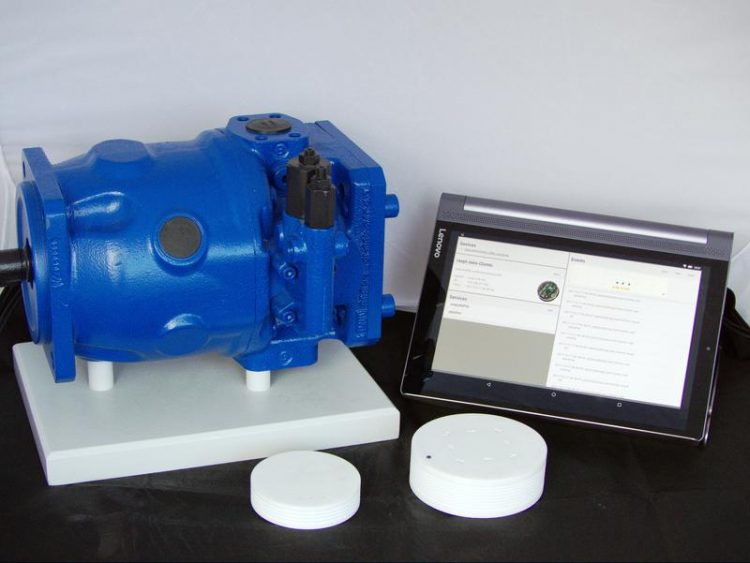Hannover Messe 2018: Cognitive system for predictive acoustic maintenance

Predictive Maintenance at Hannover Messe: configured wireless sensor nodes (in the foreground) send status messages of the axial piston pump (left) to a tablet. Picture © Fraunhofer IDMT
Axial piston pumps convert mechanical into hydraulic energy. On construction or agricultural machinery, they help to lift heavy loads or are part of industrial conveyor technology.
“So far, these systems have not had permanently installed acoustic condition monitoring”, reports Danilo Hollosi, Head of “Acoustic Event Recognition” of the Oldenburg Project Group for Hearing, Speech and Audio Technology at the Fraunhofer Institute for Digital Media Technology IDMT. “Cognitive systems can be very powerful in this regard. We have illustrated this with our new demonstrator.”
Recognize early when it is no longer running smoothly
Together with partners, the scientists have mounted on axial piston pumps batteryoperated sensors that are able to record the noise of the pump via the air, to process it, to compare it with reference audio data and to send the information wirelessly to a digital evaluation unit.
Not only can conclusions about possible undesirable developments be identified at an early stage; statements about the nature of the problems can also be made – for example, if there are problems concerning bearing clearance or hydraulics. This provides the opportunity to intervene before major damage to powertrains or hydraulics occurs.
Use of machine learning methods
“We have trained the cognitive system with machine learning based on previously acquired pump audio signals”, Hollosi says. A central infrastructure for data processing is not necessary. This saves costs: while servers can consume amounts in the five-digit range, the price per sensor remains in the double-digits. Another advantage: signal processing on site will require less data for training. “Customers benefit from a datasecure technology platform that is suitable for a wide variety of audio scenarios andthat can be easily retrofitted and scaled to any size.
The networking of sensors via the Internet for remote maintenance is also possible”, Hollosi adds, summarizing the advantages. In this process, the Fraunhofer IDMT incorporates the expertise of its project group Hearing, Speech and Audio Technology in Oldenburg. “Our colleagues are experts in technologically recreating the capabilities of the human ear. They teach the systems to adhere to given parameters when evaluating audio data, to take into account environmental noise patterns and to exclude out background noise”, says Hollosi.
Ready for the market: Technology Readiness Level 8
The technology is funded by the BMBF (German Federal Ministry of Education and Research) in the ACME 4.0 project. In the meantime, the partners have reached the 3rd project year and Technology Readiness Level 8. “Our prototype works,” says Hollosi. In 2018, it will be field-tested. At the same time, the scientists are working with Infineon on predictive maintenance for chip production. The demonstrator will be shown by the Fraunhofer IDMT at the Hanover Trade Fair: A loudspeaker will play the operating noise of the axial piston pump. Wireless sensor nodes can be configured via a tablet. The feedback on the detected acoustic event is then displayed on the tablet.
Media Contact
All latest news from the category: Trade Fair News
Newest articles

NASA: Mystery of life’s handedness deepens
The mystery of why life uses molecules with specific orientations has deepened with a NASA-funded discovery that RNA — a key molecule thought to have potentially held the instructions for…

What are the effects of historic lithium mining on water quality?
Study reveals low levels of common contaminants but high levels of other elements in waters associated with an abandoned lithium mine. Lithium ore and mining waste from a historic lithium…

Quantum-inspired design boosts efficiency of heat-to-electricity conversion
Rice engineers take unconventional route to improving thermophotovoltaic systems. Researchers at Rice University have found a new way to improve a key element of thermophotovoltaic (TPV) systems, which convert heat…



